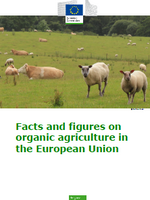New report from the European Commission: Facts and figures on organic agriculture in the European Union
Report on the status of organic farming in Europe 2011, prepared by the Directorate General of Agriculture and Rural Development of the European Commission with the support of Eurostat and the OrganicDataNetwork project.
The organic sector in the EU has been rapidly developing during the past years. According to Eurostat data, the EU-27 had in 2011 a total area of 9.6 million hectares cultivated as organic, up from 5.7 million in 2002 according to a recent report of the European Commission.
During the last decade, organic area in the EU improved by about 500 000 hectares per year. This is a big increase, but the whole organic area represents only 5.4% of total utilised agricultural area in Europe. Most of the organic land (78%) and of organic farms (83%) are situated in the EU Member States having joined the EU before 2004 (the so called EU-15), in which national and European legislation, among others, helped stimulate the development of this sector.
The European countries having joined the EU since 2004 (called in the report the EU-N12) are not lagging behind and are quickly expanding the organic sector as well. They registered a 13% yearly growth rate in their organic area from 2002 to 2011 and saw their number of holdings increase almost tenfold between 2003 and 2010.
But are organic holdings showing particular trends in comparison with conventional ones or are their managers different? Organic holdings tend to be bigger than conventional farms in the European Union. Data on organic farm managers shows that these tend to be generally younger than the average conventional farmers in Europe but that as for conventional farms, these holdings would tend to be managed by males rather than females at the level of the EU. The education of farm managers shows that women working in organic farming tend to acquire more vocational training than women working in conventional farms.
More than 270 000 organic operators (producers, processors and importers) were registered in the EU-27 in 2011. A major part of these operators (about 235 000) was represented by agricultural producers, who may also process and/or import organic products, and which were mostly active in the EU-15.
Though about 11 600 producers were counted in the EU-N12 in 2002 their
number grew to more than 50 000 in 2011, also as a result of additional
financing provided by the European Union for this type of production following
their accession.
Organic farms are active both in the arable crop and orchard as well as animal sectors.
Figures show that at EU level both types of production are registering a positive trend for the studied years. But what sort of crop or animal products come out of organic production?
Data shows that permanent pasture represen ts the biggest share of the organic area (about 45%), followed by cereals (around 15%) and permanent crops (about 13%).
Sheep (46%) and cattle (30%) are the most important types of organic animal production at European level, with the exception of poultry. However, other types of animal production should be mentioned in the EU-27, such as pigs, which registered 10%, and goats, which were at 6% of organic production in Europe in 2011.
The report gives an indication of the situation of organic agriculture in Europe, for given years, according to data availability. Since detailed data is not available for all countries and varies within the Eurostat databases, other sources and own estimations were used in this report.
Source: Facts and figures on organic agriculture in the European Union October 2013
More information
- EC.Europa.eu: Facts and figures on organic agriculture in the European Union
- Organic-Europe.net: Statistics, data tables
- Organic-World.net: Europe: Current statistics by Helga Willer and Julia Lernoud; Organic Agriculture in Europe; Graphs, Organic Agriculture in Europe: Tables (from the FiBL survey on organic agriculture in Europe) (113.4 KB)
 This website was archived on January 11, 2020 and is no longer updated.
This website was archived on January 11, 2020 and is no longer updated.
